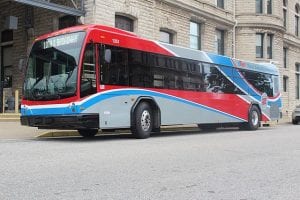
Photo by Lavonterez via Wikimedia Commons, CC BY-SA 3.0
Last May, I got my first glimpses of Louisville, Kentucky, from the windows of a public bus. As we crossed railroad bridges, passed a campus, and slid between blocks of neat Victorian homes, we learned from the bus driver about how many more jobs there were in Louisville compared to Toledo where she’d come from, and we chatted about the royal wedding. Approaching the hotel on foot from the bus stop two blocks away, I was welcomed by some of downtown Louisville’s ubiquitous street art, including gigantic walk-through bourbon barrel staves, and I got a quick look at the Ohio River before heading inside.
The 30-minute ride cost me $1.75, which for the penny-conscious nonprofit business traveler is a pretty good deal compared to a taxi, rideshare, or airport shuttle.
I don’t know if I was the only attendee who arrived at that conference from the airport by bus, but I wouldn’t be surprised, given that neither the conference organizers nor the hotel listed it in their transportation from airport options. And they are not alone. In my eight years of attending at least half a dozen conferences a year, the number of conference logistics emails or travel FAQs [frequently-asked questions lists] that I’ve seen include information on bus routes from the airport is small, if indeed there were any.
If these were corporate events, I could chalk this up to snobbishness, but the events I travel to are universally concerned with some aspect of fighting poverty and developing healthy, affordable communities, and it’s extremely clear that a strong public transit system is a core component of those goals. As Dace West, former executive director of Mile High Connects in Denver wrote in NPQ, transit can “enhance access to opportunity for low-income communities and communities of color by connecting them to affordable housing, healthy environments, quality education, and well-paying jobs”—or, of course, lack of transit access can impede access to these things.
Our nonprofits often advocate for local transit spending, but when we gather, we seem to forget these values. How would we know what the transit of a given city is like if we never ride their buses? Worse, we typically support ride-hailing services with our dollars that often contribute to the very problems of poverty our conferences aim to address.
What is behind this neglect? I have to chalk it up to ignorance and habit. And it may also be a symptom of the fact that nonprofit professionals are still too often not drawn from the ranks of the people they supposedly serve.
For any of us who came of age before Google Transit, public buses were by-and-large the province of those without other choices. Slower and less predictable than trains, their routes, stops, and schedules were almost impossible to decipher. They varied by day and hour, with mysterious codes after their route numbers (Oh no, the 28B doesn’t stop here, just the 28A). Figuring them out tended to involve a trip to the library to puzzle over a pile of abstracted route maps, and a lot of trial-and-error, unless you had the luck to score a few conversations with someone who knew how the particular trip you wanted to make worked. It’s understandable that many of us, even those who grew up riding trains and subways, do not think of the bus.
Public transit is also often a pretty segregated world. The fractured Detroit bus systems is perhaps one of the most blatant examples— the suburban system stops making stops once it hits the city line with its payload of commuters until it gets to downtown and a separate system serves the mostly Black residents of the city. In Los Angeles in the 1990s, the Bus Riders Union even brought a successful civil rights lawsuit against the transit agency for over-investing in its subway system, which primarily served white commuters, while the bus system that served people of color remained severely overcrowded and underserved. In suburban New Jersey, where I grew up, white professionals rode the commuter rail all the time, but they wouldn’t set foot on a bus. My parents faced uncomprehending horror from other parents when they heard they’d let me take a bus to the mall as a teenager.
I remember once hearing Angela Glover Blackwell, PolicyLink’s founder, connect racism and environmentalism by pointing out that we need to be willing to sit next to people different from us in order to make meaningful change in our wasteful transportation systems possible. But would we actually get on a bus and do it?
Happily, bus travel is different now—although limited routes and time tables still restrict the job and housing choices of those dependent on transit. Especially in the smaller systems, the experience of bus travel has unequivocally been improved by technology. Just as with driving, all you need is an address and Google Maps, or a similar app, to figure out which buses to take and where the stops are. In many places, those buses are GPS (global positioning system)-equipped, so the apps will also tell you if they are running late and when they are expected. Often, you can buy preloaded cards and day passes to cut down on the need for exact change. It’s a whole new world, at least for the casual rider.
(Are buses perfect? No. But I can report anecdotally that the only time I’ve been stranded by airport transportation involved a pre-booked Super Shuttle.)
Transit systems are absolutely crucial for the people who rely on them. One of the less touted results of some of the big data crunching about mobility out of poverty that has happened over the past several years is that good transit is actually the top factor for helping adults move out of poverty. But our transit systems are struggling. They have lost riders because they cut service during the recession. They are facing competition from gig economy ride-hailing companies, which, despite their claims of reducing car use appear to be mostly drawing users away from transit and walking. They are facing budget cuts and a draconian federal environment for transit funding. And despite the flashy attention given to new, expensive light-rail systems and streetcars, in most places, it’s the bus system we need to focus on.
That Louisville system that I rode last May, known as the Transit Authority of River City or TARC, despite working well for me, desperately needs to expand its routes to reach more job centers. After some news coverage of excruciatingly long commutes and limited options, its CEO told the LEO [Louisville Eccentric Observer] Weekly that he “wants TARC to help people participate in what the community has to offer, but expanding routes and frequency would require more money—and TARC is already having to work hard to get the funding it needs to maintain its current level of service.”
Transit funding has become the locus of a number of spirited and often successful organizing efforts from Indianapolis to St. Louis to Baton Rouge. But as long as bus transit remains something only considered by those with no choices, it will be an uphill battle.
Walking (or Riding) the Talk
Given all this, it seems like considering how to encourage people to take public transit when we organize an event should go hand in hand with walking our talk—considerations like avoiding hotels whose workers are striking or seeking out local food and beverage for offsite receptions.
If your nonprofit’s mission involves fighting poverty, improving health, traffic safety, strengthening community, fighting climate change, or improving independence for youth, seniors, or the disabled, you have a direct interest in supporting transit systems.
Now, taking the bus in from the airport won’t work for everyone, in every place, at every time, of course. But the great thing about adding public transit as an option to your logistics emails and conference website is that it constrains no one, and literally costs you nothing more than five minutes of research on Google Maps (for routes and schedules) and the transit agency website (for fares). Bonus five minutes if you want to take the time to suggest to your venue that they add it to their website too. (Super extra credit if you organize a tour that travels by transit.)
In my experience, when you suggest the idea of taking the bus, most just haven’t thought of it. I once spent a delightful couple hours exploring the White River State Park in Indianapolis on my way back to the airport with a colleague because I’d noticed it was on the bus route and we had some time to spare. She was a regular subway commuter at home, but the idea of taking the bus in a strange city hadn’t occurred to her until I mentioned it. She was delighted to see more of the city, including a beautiful new transit hub and the park, get some fresh air and her step count in before flying home, and benefit from the increased schedules that IndyCAN had fought so hard for.
Of course, your conference attendees by themselves are not going to save a transit system over the course of a three-day event. Organizing and advocacy will always be necessary over individual choices to make meaningful change. But institutional voices can help lay foundations for that kind of change by challenging narratives and assumptions. This can be one of those cases. Put the bus on the list.
This article originally appeared on Nonprofit Quarterly.




Nice reflection and so true. I recently regained my appreciation for bike/bus commuting now that my daughter can drive, and it’s been far easier and more enjoyable than I could have imagined. My experiences in greyhounds in the 90’s contributed to my commitment to community development, and I’m grateful to have rekindled this love.
Great article and gave me something to think about. In Richmond, VA we have a new and semi-improved rapid transit bus line that is increasingly popular as it connects people in the urban, downtown areas to jobs and commerce in the suburbs. As a nonprofit communications professional, I plan to include public transit directions in my organization’s events details going forward.
Got on the plane in Portland Oregon headed to the NWA NTI in Pittsburgh. Read your article along the way and was a nice refresher on why I often take public transit, particularly buses and light rail. Thanks Miriam! I usually try to take public transportation when I am on business trips. Get to see the city, who rides transit and save a few bucks. Reminds me why I do the work I do.
The Pittsburgh airport bus is great — has its own dedicated road along an old trolley line for a chunk of the way!
Railvolution—a smart growth conference originated by then Portland Representative Earl Blumenauer—gives conference attendees a pass good on the transit agencies (bus and rail) serving the conference. This is the gold standard for transit at US conferences.
I always try to ride the bus whenever I go to a conference. I spent a day after a conference in Milwaukee last year riding buses around the city, and I had a great time doing it.